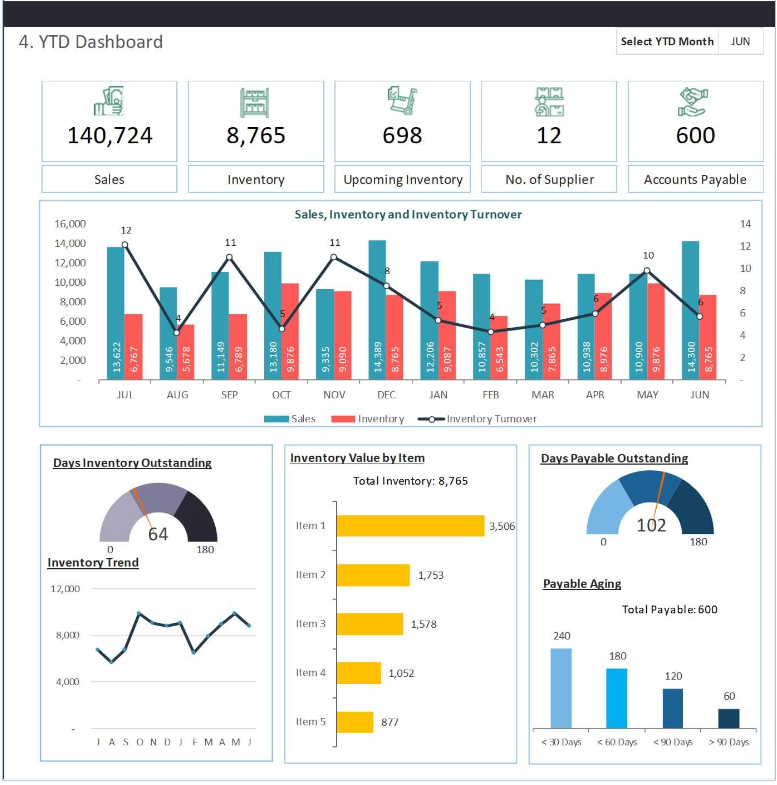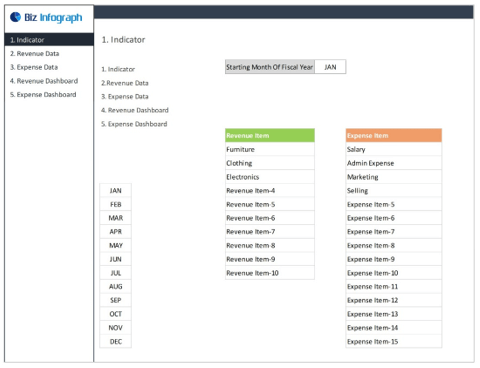
Biz Infograph inventory dashboards
Inventory management is the backbone of any business that deals with physical goods. It’s the art of finding that delicate balance between having enough stock to meet demand while avoiding overstocking, which ties up capital and increases carrying costs. In this dynamic world of supply chains, markets, and consumer preferences, strategic inventory management is a game-changer.
What if we told you there’s a powerful tool at your disposal to master this art? Enter dashboards, the unsung heroes of modern inventory management. In this comprehensive guide, we’ll explore how to strategically manage your inventory using professionally designed dashboards.
Why Inventory Management Matters?
First, let’s set the stage. Why is inventory management so crucial? Well, it’s not just about having items on the shelf or in the warehouse. It’s about cash flow, customer satisfaction, and operational efficiency. Effective inventory management can:
Boost Cash Flow: By preventing capital from getting tied up in excess stock.
Enhance Customer Satisfaction: By ensuring products are available when customers want them.
Reduce Costs: By minimizing storage and carrying costs.
Improve Operational Efficiency: By streamlining supply chain processes.
The Power of Dashboards in Inventory Management
Now, imagine having real-time visibility into your inventory, easy-to-read charts that highlight trends, and automated alerts for potential issues. This is where dashboards come into play.
Dashboards are like the cockpit of a plane, giving you a bird’s-eye view of your inventory landscape. They transform raw data into actionable insights.
In this guide, we’ll delve into the best practices for strategically managing your inventory using dashboards. Whether you’re a seasoned supply chain manager or a business owner looking to optimize your inventory processes, this information is for you.
Let’s embark on this journey of inventory enlightenment, where we’ll demystify the power of dashboards and equip you with the knowledge to revolutionize your inventory management. It’s time to make your supply chain more efficient, cost-effective, and customer-centric. The world of strategic inventory management using dashboards awaits.
Best Practice 1: Demand Forecasting and Predictive Analytics
Effective inventory management begins with accurate demand forecasting. Predicting future demand allows you to stock just the right amount of inventory, preventing overstocking and stockouts.
The Foundation of Effective Inventory Management:
Demand forecasting is the cornerstone of inventory management. This way, you can predict future demand with precision. This forms the basis for your inventory decisions.
Utilizing Historical Data and Market Trends:
Historical sales data offers insights into seasonal variations and demand patterns. Additionally, monitor market trends, customer preferences, and economic factors that might influence demand. Combining historical data with market insights enables more accurate forecasting.
Best Practice 2: Real-Time Inventory Tracking
Real-time visibility into your inventory is a game-changer. It empowers you to make proactive decisions, respond to changes swiftly, and avoid costly stockouts or overstocking scenarios.
The Importance of Real-Time Visibility:
Traditional inventory tracking methods rely on periodic manual counts, leaving room for errors and delays in decision-making. Real-time tracking, often facilitated by barcode scanners, RFID, or IoT devices, ensures you’re always aware of your inventory levels.
Implementing RFID and IoT for Tracking:
Consider adopting Radio-Frequency Identification (RFID) or Internet of Things (IoT) devices to monitor inventory in real-time. These technologies provide accurate data on item location, movement, and status, reducing the chances of errors.

Inventory-deck
Best Practice 3: ABC Analysis
Not all inventory items are created equal. The ABC analysis helps you categorize items based on their value and impact, allowing you to allocate resources more efficiently.
Categorizing Inventory for Strategic Focus:
ABC analysis classifies inventory into three categories: A, B, and C. ‘A’ items are high-value, ‘B’ items are moderate in value, and ‘C’ items are low-value but often high in volume. By categorizing items, you can prioritize your management efforts.
Prioritizing High-Value and High-Impact Items:
‘A’ items typically require closer attention, as they represent a significant portion of your inventory value. Focusing on these items ensures that you optimize the allocation of capital and resources where they matter most.
Best Practice 4: Safety Stock Optimization
Optimizing safety stock balances the need for risk mitigation with cost efficiency.
Balancing Risk and Reward:
Safety stock helps prevent stockouts, which can lead to lost sales or dissatisfied customers. However, carrying excess safety stock increases holding costs. Striking the right balance is essential to cost-effective inventory management.
Calculating and Managing Safety Stock:
Calculating safety stock involves considering factors like lead time variability, demand variability, and service level targets. Advanced inventory management software can assist in precise safety stock calculations.
Best Practice 5: Supplier Collaboration and Communication
Effective collaboration with suppliers is a cornerstone of efficient inventory management. It ensures a smooth flow of goods, reduces lead times, and minimizes the risk of stockouts.
Building Strong Relationships with Suppliers:
Cultivating strong relationships with suppliers can lead to benefits like shorter lead times, preferential treatment during shortages, and negotiated pricing. Communication is key to building these relationships.
Ensuring a Smooth Flow of Goods:
Collaborate with suppliers to establish efficient ordering processes. Implement technologies like Electronic Data Interchange (EDI) to automate order placement and tracking, reducing manual errors.
Best Practice 6: Automation and AI in Inventory Management
Automation and artificial intelligence (AI) technologies are revolutionizing inventory management. They can streamline repetitive tasks, provide data-driven insights, and enhance decision-making.
Streamlining Repetitive Tasks:
Automation can handle routine tasks like data entry, order processing, and replenishment, freeing up human resources for more strategic activities.
AI for Predictive Ordering and Inventory Optimization:
AI algorithms can analyze vast datasets to predict demand patterns, optimize order quantities, and suggest inventory levels. These insights lead to better inventory decisions.
Best Practice 7: Inventory Turnover Ratio
Monitoring your inventory turnover ratio helps ensure efficient inventory utilization. This metric reflects how quickly your inventory is sold and replenished.
Maximizing Efficiency in Inventory Utilization:
A high inventory turnover ratio indicates efficient use of inventory. It reduces holding costs and minimizes the risk of obsolete stock.
Calculating and Improving Inventory Turnover:
Calculate your inventory turnover by dividing the cost of goods sold (COGS) by the average inventory value. Identify strategies to improve this ratio, such as reducing excess stock or negotiating shorter lead times with suppliers.
By incorporating best practices into your inventory management approach and leveraging dashboards for data-driven insights, you can optimize your supply chain operations and ensure inventory is a strategic asset rather than a liability.

Elevate Your Inventory Management with Biz Infograph
In the ever-evolving world of inventory management, the combination of dashboards and inventory management solutions is a game-changer. It empowers you to make data-driven decisions, optimize stock levels, and make sure that your inventory is a strategic asset rather than a liability.
Ready to begin inventory management using dashboards? Explore Biz Infograph’s professionally designed dashboards and inventory management solutions.
Whether you’re a small business looking to improve efficiency or a large enterprise seeking to optimize complex supply chains, our tools can help you achieve your inventory management goals.